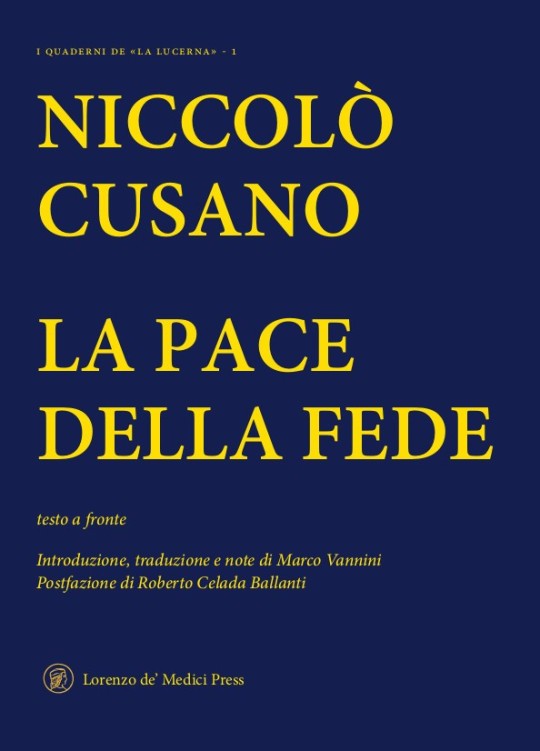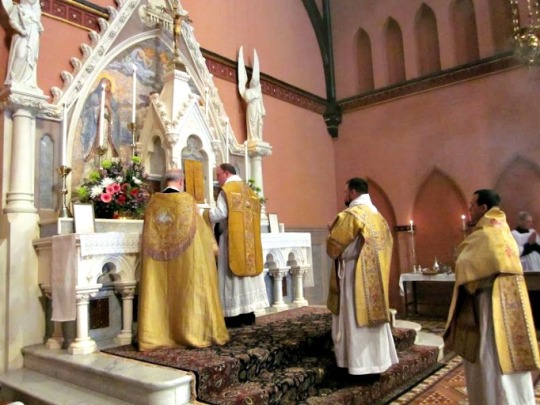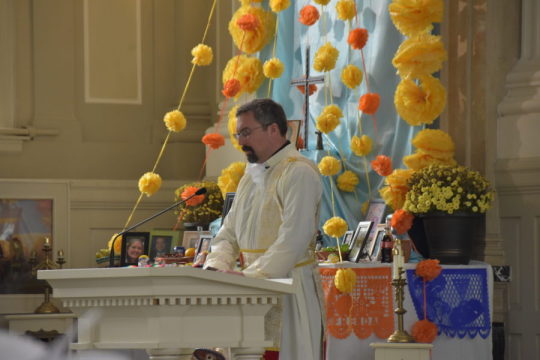#De pace fidei
Explore tagged Tumblr posts
Text
Niccolò Cusano: LA PACE DELLA FEDE. Introduzione, traduzione e note di Marco Vannini. Prefazione di Roberto Celada Ballanti - LdM Press
Niccolò Cusano: LA PACE DELLA FEDE. Introduzione, traduzione e note di Marco Vannini. Prefazione di Roberto Celada Ballanti Lorenzo de’ Medici Press Nel 1453, subito dopo la conquista di Costantinopoli da parte dei Turchi, mentre i più progettavano una nuova crociata, Niccolò Cusano scrisse il De pace fidei. In esso si immagina un Concilio tenuto in cielo tra i filosofi di tutte le religioni,…

View On WordPress
#De pace fidei#La pace della fede#LdM Press#Lorenzo de’ Medici Press#Marco Vannini#Roberto Celada Ballanti
0 notes
Text
So, I’m about two thirds of the way through Nicholas Cusanus’s De Pace Fidei. And it’s interesting for a number of reasons.
First, we have the fact that the work is motivated by an abhorrence for religiously motivated violence. In the 15th century. Written by a Catholic cardinal.
Second, this work exemplifies the attitude that became mainstream in the Catholic Church after the publishing of Nostra aetate in 1965; namely, that while the Catholic Church contains the fullness of truth, other religions have degrees of truth within them and are earnest attempts to reach the Divine. Again, I can’t emphasize this enough, this was written in the middle of the 15th Century.
Third, this work recognizes the legitimacy of the Eastern Orthodox Church. This is important, because this sets precedent for the idea that the one orthodox faith can be fully manifest in distinct and separate rites.
Related to the above, just as how Western and Eastern Christianity can reenter communion without giving up their distinctions in rites, Nicholas Cusanus is building towards an idea that certain groups of Hindus, Jews, and Muslims might in theory be able to enter communion with Rome while still holding onto their own religious rites, so long as they could come to accept Christian religious dogma (perhaps not even necessarily in the same ‘theological language’ as Catholics).
Apparently his works were never condemned as being heretical; when I’m done reading this translation, I’m gonna have to find more scholarship on his life and how his works were received.
28 notes
·
View notes
Text
Antropomorfnost Boga? (ulomci Ksenofana, Ozrena Žuneca i Ćirila Čoha)
Nego, da volovi i konji i lavovi imaju ruke
i da rukama svojim slikati mogu i djelati kao i ljudi
likove bogova na svoju bi slikali sliku,
konji konjima slične, a volovi volu podobne,
i tijelu bi davali oblik na svoju prispodobu
Etiopljani kažu da su bogovi tuponosi i crni,
a Tračani da su očiju plavih i crvene kose.
Ksenofan, fragmenti B15 i B16 u prijevodu Jure Kaštelana; Diels, Hermann Predsokratovci. Fragmenti I., Zagreb 1983., str. 133.
Spinoza ovaj motiv gotovo doslovce ponavlja, rabeći doduše prispodobe prilagođene vremenu uspona znanosti:
Kad bi trokut mogao govoriti onda bi govorio upravo to da je Bog eminentno trokutan, a kružnica [bi govorila] da je Božja narav u eminentnom smislu kružna i na taj način svak bi svoje atribute pripisivao Bogu i Boga sebi činio sličnim, a sve ostalo bi mu se pokazivalo kao ružno. (Ep. 56)
Međutim, budući da svaka filozofijska kritika onakve biti Boga kakva se pojavljuje u prihvaćenim predodžbama govori ponajprije o konkretnoj epohalnoj krizi same religije, u Spinozinu ponavljanju Ksenofanova motiva krije se mnogo više od standardnog racionalističkog prigovora prosječnom tumačenju objave. Antropomorfizam religije sam po sebi znači bliskost bogova ili Boga i ljudi, njihovu načelnu usporedivost, a daje i široke mogućnosti za izgradnju i legitimaciju morala i vrednota ljudske zajednice budući da se osnovne odredbe ljudskog života mogu uvijek shvatiti kao utemeljene u božanskom poretku ili Božjoj volji.
ulomak iz Ozren Žunec, Benedikt de Spinoza, u Damir Barbarić, Filozofija racionalizma, Zagreb: Školska knjiga 1997., str. 206.-207.
Finiti ad infinitum nulla est proportio. (Nikola Kuzanski, De visione Dei, 23.)
Između konačnog i beskonačnog, nema nikakvog odnosa. Čovjek kao istraživač mjeri istinu svojom vlastitom mjerom i tako biva mjera svih stvari. Približava se istini ali o njoj ne može imati znanje. Prava mjera istine je Bog, Beskonačno. Ljudskom mjerom je ono božansko neizmjerljivo. Poimanje toga moguće je kroz poimanje kruga. Tako je Kuzančeva čuvena rasprava De docta ignorantia, (O učenom neznanju) gdje se predmet tog (ne)znanja, istina, izlaže kao coincidentia oppositorum, promišljanje kruga. U prvom poglavlju stoji:
Svako se istraživanje sastoji u postavljanju odnosa i poredbi, bilo to jednom lakše drugi put teže. Ono beskonačno kao beskonačno nespoznatljivo je zato što izmiče svakoj usporedivosti.
Da je problem spoznaje općenito usporediv sa spoznajom kruga izričito se kaže u trećem poglavlju:
Konačni um ne može precizno dosegnuti istinu o stvarima. Istina nije nešto više ili nešto manje već je nedjeljiva. Ono što nije istina ne može precizno mjeriti istinu. Za usporedbu, ono što nije krug ne može mjeriti kružno koje je nedjeljivo.
Ova se usporedba u nastavku još jače produbljuje:
Intelekt je spram istine kao (upisani) mnogokut prema (opisanom) krugu. Što upisani mnogokut ima više kutova to je sličniji krugu. Pa ipak, čak ako se broj kutova poveća u beskonačnost, mnogokut nikada ne postaje jednak krugu. Savršena preciznost bila bi identitet
Ovo svojstvo kruga kojim se on pokazuje kao paradigma odnosa ljudske i božanske mjere, odnosno spoznaje, najopširnije je prikazana u jednom od kasnijih djela Kuzanskog, u De quadratura circuli. Dokazujući kako je kvadratura kruga nemoguća Kuzanski navodi razlog da kvadrat ili bilo koji mnogokut i krug nisu entiteti iste vrste, premda se može utvrditi da određeni mnogokut može doći bliže zadanom krugu od drugog. Mnogokut može biti veći ili manji ali ne može dosegnuti apsolutni maksimum ni u stvarnosti ni u mogućnosti. U usporedbi sa mnogokutima koji dopuštaju veće i manje, područje kruga je područje apsolutnog maksimuma. Ono što se broji ne može dosegnuti snagu shvaćanja jedinstva, a mnogostrukost ne može dosegnuti snagu jednostavnosti. Svi teolozi žele dosegnuti vječnost sličnu krugu, jedinstvenu i najjednostavniju. Ali konačna moć je nesumjerljiva sa bilo kojom ne-beskonačnom, kao što područje kruga ostaje nesumjerljivo sa bilo kojim područjem ne-kruga. Krug je savršen lik i sadrži sva moguća savršenstva likova; njegova površina uključuje sve površine i nema ništa zajedničko s bilo kojom od njih; u sebi je jedinstvena i jednostavna; on je apsolutna vječnost forme svih formi i opet nema ništa zajedničko ni sa jednom formom.
Kada bi lav pogledao na lice Boga, vidio bi ga kao lava, jelen u obliku jelena, a orao kao orla... Na taj način u svim pogledima to lice svih lica je zaklonjeno, i kao u zagonetki ne može biti otkriveno. (Nikola Kuzanski, De visione Dei, VI.)
U De Pace Fidei Kuzanski u istom duhu govori o nemogućnosti svođenja svih religija na jednu. Tu pripovijeda kako su pred prijestolje Božje došli predstavnici svih naroda i svih religija žaleći se na to da ih raznorodnost vodi u sukobe i mržnje. Molili su ga da im pokaže svoje pravo lice i da im tako omoguće svima zajedničku religiju. No Bog ih nije uslišao, istina o Bogu prisutna je u svim religijama ali na taj način što te religije upućuju na njenu odsutnost. Ta bi se istina izgubila kad bi sve religije bile svedene na jednu. To je kao u krugu: pravilni mnogokut se približava krugu, i što ima više kutova tim je veća ta bliskost, ali ipak on nikada neće postati krug. Pokušaj poistovjećivanja kruga na jedan od pravilnih mnogokuta pa ma koliko stranica imao ukinulo bi istinu kruga.
Svako biće teži da odredi Boga unutar svoje ograničene egzistencije: tako trokut želi triangulaturu, a kvadrat kvadraturu kruga i tako dalje sa svim drugim mnogokutima. Krug, kao i Bog, apsolutno nadmašuje svaku mjeru mnoštva jer je on veći od bilo koje istražive mjere. On nadilazi i svaku finu mjeru najmanje frakcije jer je on finiji od svih frakcija. On ne može biti precizno dohvaćen niti uzlaženjem niti silaženjem.
Ćiril Čoh, Krug - mjera istraživanja i bivanja, 2006.
2 notes
·
View notes
Quote
You set over Your people different kings and different seers, called prophets - very many of whom, in their role as Your legates, instituted worship and laws and instructed an uneducated people. [People] accepted these laws just as if You Yourself, the King of kings, had spoken to them face to face; they believed that they heard not kings and prophets but You Yourself in and through kings and prophets.
- Nicholas of Cusa, De Pace Fidei (1453)
2 notes
·
View notes
Quote
Therefore, when man is called by omnipotence out of not-being, then unity arises as first in order, after which equality and then the connection of both. For nothing can exist, unless it is one. The one is therefore prior. And since man is called out of not-being, the unity of man arises as first in order, then the equality of this unity or entity—that is, the equality is the unfolding of form in unity, on account of which it is called the unity of man and not of the lion or some other thing. However, the equality can only arise out of the unity, for not otherness, but rather unity or identity produces equality. Finally, love or connection proceeds from unity and equality. That is, unity is not separable from equality and equality from unity. The connection or love is therefore such that, with the positing of unity equality is posited, and with the positing of unity and equality love or connection is posited. If therefore no equality is found, without it being the equality of unity, and if no connection is found, without it being the connection of unity and equality, such that the connection is in unity and equality, equality is in unity and the unity is in equality, and unity and equality are in connection, then it is obvious that there can be no essential distinction in the trinity. Namely, everything that is essentially different is such that the one can be, without the other existing. However, because the trinity exists such that, with the positing of unity the equality of unity is also posited and conversely, and with the positing of unity and equality connection is also posited and conversely, it is seen not in the essence, but in the relationship, in what manner one is unity, another is equality, and another is connection. However, a numerical distinction is essential. Indeed, the number two differs essentially from three. With the positing of the number two, three is not posited, and the three does not follow from the existence of two. Therefore, the trinity in God is not composed, plural or numerical, but rather the simplest unity. Whoever believes therefore that God is one, does not deny that He be threefold, insofar as he understands that Trinity as not different from the simplest unity, but rather as unity itself, such that that trinity, were it not in unity, were also not the origin, which is so omnipotent that it can create the universe and each individual. The more unified a power is, the more powerful it is; however, the more unified it is, the simpler it is. Therefore, the more powerful or stronger it is, the simpler it is. Hence if the divine essence is omnipotent, it is completely simple and threefold. For without trinity it were not the simplest, strongest, and omnipotent origin.
From De Pace by Fidei Nicholas of Cusa
1 note
·
View note
Text



1. Pope Francis celebrating the Zaire Use of the Roman Rite, the first Sunday of Advent, 2019. (x) 2. Clergy celebrating the Anglican Use of the Roman Rite in Mount Calvary Church, Baltimore. (x) 3. A priest celebrating the Holy Qurbana according to the Syro-Malabar Rite at Mundelein Seminary, December 2018. (x)
Everything that the Church has to offer must become incarnate in a distinctive way in each part of the world, so that the Bride of Christ can take on a variety of faces that better manifest the inexhaustible riches of God's grace. Preaching must become incarnate, spirituality must become incarnate, ecclesial structures must become incarnate.
- Pope Francis (Querida Amazonia, §6ab)
And the nations, despite a difference of development due to diverse conditions of life and culture, are not destined to break the unity of the human race, but rather to enrich and embellish it by the sharing of their own particular gifts and by that reciprocal interchange of goods which can be possible and efficacious only when a mutual love and lively sense of charity unite all the sons of the same Father and all those redeemed by the same Divine Blood.
- Pope Pius XII (Summi Pontificatus, §43)
Where conformity of mode cannot be had, nations are entitled to their own devotions and ceremonies, provided faith and peace be maintained. Perhaps as a result of a certain diversity devotion will even be increased, since each nation will endeavor with zeal and diligence to make its own rite more splendid […] if you will deign to do this, the sword will cease, as will also the malice of hatred and all evils; and all will know that there is only one religion in a variety of rites [Latin: una religio in varietate rituum]
- Nicholas of Cusa (De Pace Fidei, §67d, 6a)
15 notes
·
View notes
Quote
For circumcision does not save; rather, there is salvation without it. Nevertheless, when some man does not believe that circumcision is necessary in order to obtain salvation but yet he allows it to be done to his foreskin in order to be more like Abraham and his followers even in this respect, then such a man is not condemned on account of his circumcision, provided he have the previously mentioned faith. Thus, Christ was circumcised and many Christians after Him - as are still Ethiopian Jacobites and others, who [though circumcised] are not circumcised in the belief that {it} is a sacrament necessary for salvation.
De Pace Fidei (60)
1 note
·
View note